Thrust Area |
Local Structure, Magnetism, and Nanomaterials
The Lujan Neutron Scattering Center encompasses a set of powder diffractometers, instrument scientist specialists, and sample environments (pressure, temperature, and magnetic field) equipped to address challenges in basic and applied science in local structure, magnetism, and nanomaterials. Three powder diffractometers focus on the diffraction needs for nuclear and magnetic structure determination in the fields of condensed matter physics, chemistry, earth sciences, materials science and engineering. These instruments provide access to total scattering and high and medium resolution structure studies, providing insight into nuclear structure, local atomic arrangements, magnetic structures, and magnetic moments in materials. A flavor of the diversity of science utilizing these capabilities is provided below. Instrument and contact information is also provided.
For information about polarized beam reflectometry, and its applications in determining magnetic ordering in single crystals, thin films, and layers, please see the Surfaces and Interfaces Science Thrust Area.
- Local Structure Capabilities
- Diffraction Capabilities
- Instruments and Contacts
Local Structure Capabilities
Total scattering methods, incorporating Bragg and diffuse scattering, have been increasingly used over the last 20 years to study the departure of local atomic structure from average crystallographic structure in an array of materials. A material's Pair Distribution Function (PDF) provides directly both local structure correlations at low real-space dimensions, and intermediate- and long-range order at higher length scales. Many materials can be studied with these capabilities: examples in complex, nano, and disordered materials appear below.
Complex Materials
Total scattering can address local structure features in complex materials such as superconductors, ferroelectrics, thermoelectrics, and frustrated systems.
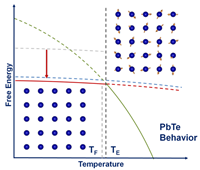
Local dipoles in canonical thermoelectric materials
Neutron total scattering and PDF analysis (NPDF instrument) reveals the existence of a novel paraelectric state in PbTe at and above room temperature. On cooling the structural dipoles do not order, but disappear, resulting in an undistorted rock-salt ground-state. The result suggests new thermoelectrics should be sought among materials that, like PbTe, are close to a ferroelectric instability.
E. Bozin, et al., Science 330 (2010). DOI: 10.1126/science.1192759
Nanomaterials
Nanomaterials present an extreme in the absence of perfect crystallinity, making the location of every atom an especially challenging problem. Local structure studies are an emerging tool for characterizing, for example, finite size effects, surface defects, core-shell architectures, and ligand-capping in nanoparticles.
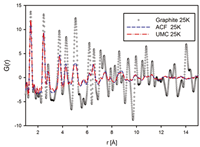
Hydrogen absorption in porous carbon structures
PDF data (HIPD instrument) is used to probe the structure of two disordered carbons: activated carbon fibers (ACF) and ultramicroporous carbon (UMC). In-plane local atomic structure is found to be similar to regular graphite, but the stacking of layers is strongly disordered. Analysis sheds light on the optimum separation of graphene sheets for hydrogen adsorption.
W. Dmowski, et al., J. Phys. Chem. C 116 (2012). DOI: 10.1021/jp209824f

Finite size effects in Ferroelectrics
PDF reveals 5 nm particles are cubic on average but are strongly distorted (with large point-charge dipoles) locally (NPDF instrument). Capping organic groups are observed by scattering for the first time (for any powder sample of a nanoparticle).
K. Page, et al., Chem. Mater. 22 (2010). DOI: 10.1021/cm100440p
Disordered Materials
Temperature effects on geopolymer binders

Pair distribution function studies enable the study of materials that lack long-range (crystallographic) order, such as bulk metallic glasses, concretes, noncrystalline polymers, and amorphization processes.
Neutron PDF analysis provides new fundamental information regarding the local atomic structure of geopolymers. The nature of water within and around the Si–Al framework and the extent of order upon heating are followed in situ (HIPD instrument).
C. E. White, et al., J. Am. Ceram. Soc. 93 (2011). DOI: 10.1111/j.1551-2916.2011.04515.x
Diffraction Capabilities
The sensitivity of neutrons to light elements and magnetic spin, as well as their abilities to distinguish neighboring elements in the periodic table, lend well to questions of crystal and magnetic structure and phase transitions in molecular crystals, metal organic frameworks, transition metal and mixed-metal oxides, metal hydrides and alloys, and more. Furthermore, the ability of neutrons to deeply penetrate sample environment equipment provides unique opportunities to study the effects of applying pressure and magnetic fields on material structure. Lujan's instrument suite includes both high and moderate resolution diffractometers for determining nuclear and magnetic structure from powders, available with varying temperature, magnetic field, and pressure. Several illustrative examples are given below.
Crystal Structure Determination
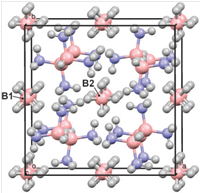
Diborane molecular crystal structure
High resolution neutron diffraction (NPDF instrument) unveils the crystal structure and hydrogen release of the diammoniate of diborane. Its crystal structure contains disordered BH4− ions in 2 distinct sites. Hydrogen release is similar to that from NH3BH3 but with faster kinetics.
M. Bowden, et al., Chem. Comm. 46 (2010). DOI: 10.1039/c0cc03249b
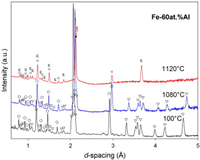
High temperature Fe-Al alloy phase
The crystal structure of the high-temperature ɛ phase of the Fe–Al system are determined by in-situ high-temperature neutron diffraction (HIPPO instrument) for the first time. Crystallographic parameters are established by Rietveld refinement of the data.
F. Stein, et al., Intermetallics 18 (2010). http://dx.doi.org/10.1016/j.intermet.2009.07.006
Magnetic Structure Determination

Antiferromagnetism in BaFe2Se3
Analysis of neutron powder diffraction data (HIPD instrument) unveiled long-range-ordered antiferromagnetism concomitant with local iron displacements in the spin-ladder compound BaFe2Se3. These iron displacements imply significant magnetoelastic coupling in FeX4-based materials, ingredients hypothesized to be important in the emergence of superconductivity.
J. M. Caron, et al., Phys. Rev. B 84 (2011). DOI:10.1103/PhysRevB.84.180409
Parametric Studies
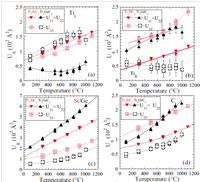
T-dependent behavior of MAX phases
The structure of Ti3SiC2 and Ti3GeC2 (so-called 312 MAX phases) are followed between 100 and 1100 °C with neutron diffraction and Rietveld analysis (HIPPO). Behavior of anisotropic thermal motion of atoms reinforces the idea that Si and Ge act as "rattlers", possibly responsible for low phonon conductivities in these materials.
N. J. Lane, et al., Phys. Rev. B 82 (2010). DOI: 10.1103/PhysRevB.82.174109
Time resolved and in-situ studies
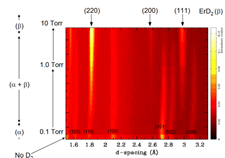
In situ D2 loading
The conversion of Er metal to the α-Er-D (solid-solution) phase and β (fluorite) phase is tracked (HIPD instrument) with in situ D2 loading of Er metal powder at 450°C. Complete conversion to ErD2 was accomplished at 10 Torr D2 pressure with deuterium fully occupying the tetrahedral sites in the fluorite lattice.
M. A. Rodriguez, et al., Powder Diffraction 26 (2011).
Instruments and Contacts:
Neutron Powder Diffractometer | NPDF

Katharine Page
Instrument Scientist
505.665.4310
kpage@lanl.gov
Joan Siewenie
Instrument Assistant
505.665.4764
siewenie@lanl.gov
High resolution powder diffraction (15 K – 1500 K), and Total Scattering Studies (for amorphous, disordered, and nano materials)
High-Intensity Powder Diffractometer | HIPD
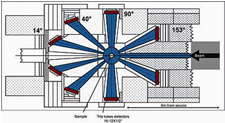
Anna Llobet-Megias
Instrument Scientist
505.665.1367
allobet@lanl.gov
Parametric studies (phase transitions, temperature dependence 5K-800K), magnetic structure and crystal structure (large d-spacing range), time dependent Total scattering.
HIPD is not in the Lujan Center User Program. It is currently utilized for LANL collaborative work.
High-Pressure-Preferred Orientation | HIPPO

Sven Vogel
Instrument Scientist
505.667.7016
sven@lanl.gov
Medium resolution and time-resolved studies of crystal and magnetic structure and texture, high temperature, and high pressure work.
More information is available for HIPPO capabilities at the Materials in Extreme Environments and Geoscience Science Thrust Area

